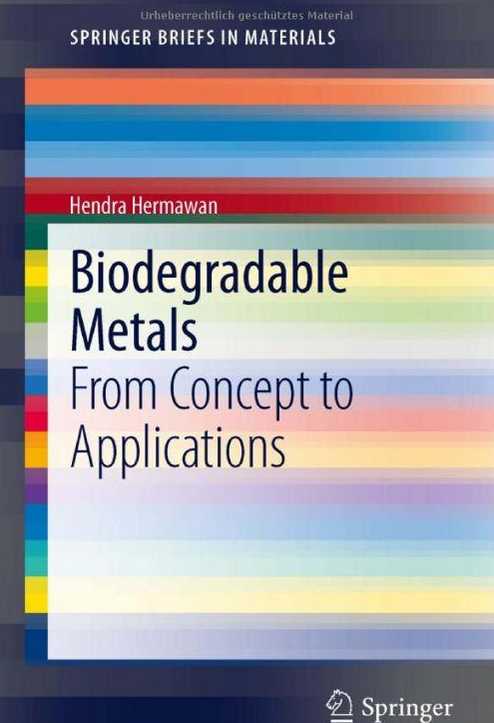Biodegradable Metals
From Concept to Applications

Preface
Since their first introduction, metallic biomaterials have always been designed to
be corrosion resistant. For decades, this paradigm has become the mainframe of
the biomaterials world. It has been cited in thousands of scientific papers and
taught in hundreds of courses of materials for biomedical devices. It has also been
followed by industries in developing millions of medical devices until today.
Nowadays, with the advent of tissue engineering, biomaterials are envisaged to
actively interact with the body. Metallic biomaterials are no more required to be
inert but they should be able to assist and promote the healing process. In many
cases, they should do their job and step away thereafter. This idea opens an
extreme new horizon and provides new insight. One can imagine designing a
material which is able to provide mechanical support for a required time and then
progressively degrade. This idea directly breaks the paradigm of corrosion-resistant
biomaterials.
Hundreds of publications on biodegradable metals are scattered in many journals
since the first one published in 2001. Three consecutive annual international
symposiums devoted to this emerging field have been held in Berlin (2009),
Maratea (2010), and Quebec City (2011). Papers presented in those symposiums
were published in special issues in Acta Biomaterialia (2010) and Materials Science
and Engineering B (2011). This book, Biodegradable Metals: From Concept
to Applications, should be the first to organize the scientific values of biodegradable
metals research since the first decade of its development.
This book contains two main parts, each consisting of three chapters. The first
part introduces the readers to the field of metallic biomaterials, exposes the state of
the art of biodegradable metals, and reveals its application for cardiovascular
implants. They were mostly compiled from the following publications: Hermawan
et al. (2009a, 2010a, 2010b, 2011). The second part exposes an example of biodegradable
metals from its concept to applications where a complete study on
metallic biodegradable stent is detailed from materials design, development,
testing till the implant fabrication. The second part was mostly compiled from my
previous works on Fe-based alloys for biodegradable stents, mainly from my
doctoral thesis submitted to Laval University in 2009, entitled: ‘Conception,
développement et validation d’alliages métalliques dégradables utilisés en chirurgie
endovasculaire’, with updates and benchmarking with recent similar works
from other authors up to 2012.
I would like to sincerely thank my mentors, Prof. Diego Mantovani and Prof.
Dominique Dube of Laval University, for their excellent supervision in my journey
in developing expertise in biodegradable metals. I acknowledge the kindness of Dr.
Lluis Duocastella of Iberhospitex Spain for giving me valuable experience in the
stent fabrication process. I thank Dr. M. Rafiq of MediTeg Universiti Teknologi
Malaysia and Mrs. Wang Dan of Biosensors Interventional Singapore for providing
images of medical implants. I thank Dr. Yossi Febriani, Amelie and Maika for
sacrificing their time during the completion of this book.
English -- 2012 edition (July 14, 2012) -- ISBN: 3642311695 -- 77 pages -- PDF -- 3 MB
Download
http://s18.alxa.net/s18/srvs2/02/003...etals.2012.rar
From Concept to Applications

Preface
Since their first introduction, metallic biomaterials have always been designed to
be corrosion resistant. For decades, this paradigm has become the mainframe of
the biomaterials world. It has been cited in thousands of scientific papers and
taught in hundreds of courses of materials for biomedical devices. It has also been
followed by industries in developing millions of medical devices until today.
Nowadays, with the advent of tissue engineering, biomaterials are envisaged to
actively interact with the body. Metallic biomaterials are no more required to be
inert but they should be able to assist and promote the healing process. In many
cases, they should do their job and step away thereafter. This idea opens an
extreme new horizon and provides new insight. One can imagine designing a
material which is able to provide mechanical support for a required time and then
progressively degrade. This idea directly breaks the paradigm of corrosion-resistant
biomaterials.
Hundreds of publications on biodegradable metals are scattered in many journals
since the first one published in 2001. Three consecutive annual international
symposiums devoted to this emerging field have been held in Berlin (2009),
Maratea (2010), and Quebec City (2011). Papers presented in those symposiums
were published in special issues in Acta Biomaterialia (2010) and Materials Science
and Engineering B (2011). This book, Biodegradable Metals: From Concept
to Applications, should be the first to organize the scientific values of biodegradable
metals research since the first decade of its development.
This book contains two main parts, each consisting of three chapters. The first
part introduces the readers to the field of metallic biomaterials, exposes the state of
the art of biodegradable metals, and reveals its application for cardiovascular
implants. They were mostly compiled from the following publications: Hermawan
et al. (2009a, 2010a, 2010b, 2011). The second part exposes an example of biodegradable
metals from its concept to applications where a complete study on
metallic biodegradable stent is detailed from materials design, development,
testing till the implant fabrication. The second part was mostly compiled from my
previous works on Fe-based alloys for biodegradable stents, mainly from my
doctoral thesis submitted to Laval University in 2009, entitled: ‘Conception,
développement et validation d’alliages métalliques dégradables utilisés en chirurgie
endovasculaire’, with updates and benchmarking with recent similar works
from other authors up to 2012.
I would like to sincerely thank my mentors, Prof. Diego Mantovani and Prof.
Dominique Dube of Laval University, for their excellent supervision in my journey
in developing expertise in biodegradable metals. I acknowledge the kindness of Dr.
Lluis Duocastella of Iberhospitex Spain for giving me valuable experience in the
stent fabrication process. I thank Dr. M. Rafiq of MediTeg Universiti Teknologi
Malaysia and Mrs. Wang Dan of Biosensors Interventional Singapore for providing
images of medical implants. I thank Dr. Yossi Febriani, Amelie and Maika for
sacrificing their time during the completion of this book.
English -- 2012 edition (July 14, 2012) -- ISBN: 3642311695 -- 77 pages -- PDF -- 3 MB
Download
http://s18.alxa.net/s18/srvs2/02/003...etals.2012.rar